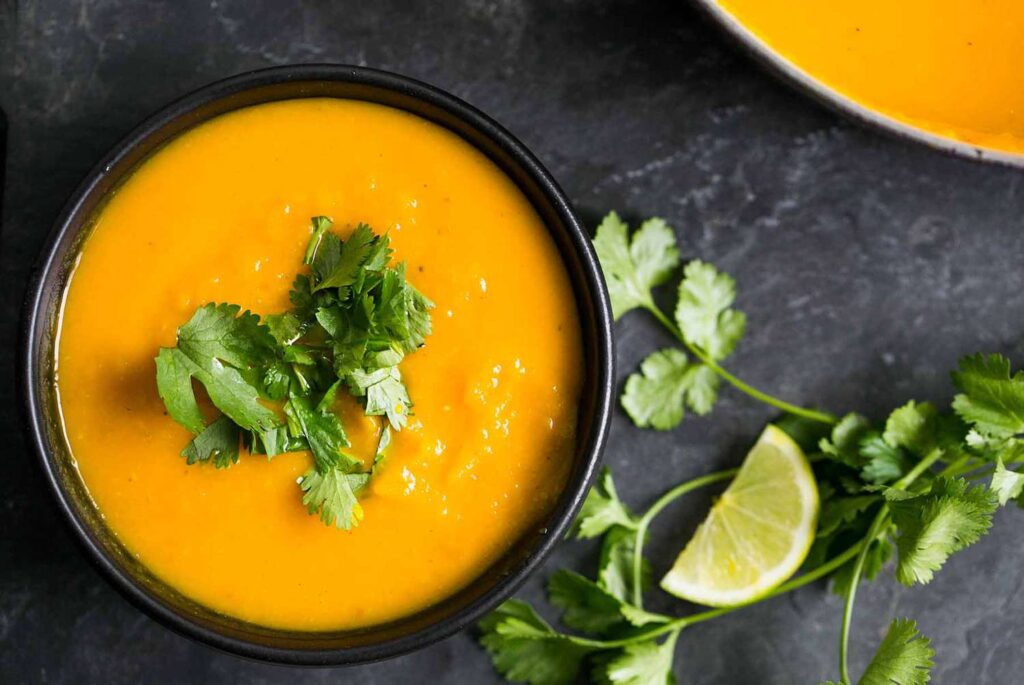Kabocha squash soup is the perfect recipe for those chilly fall evenings when you’re craving something warm and comforting. This recipe is for anyone who loves seasonal flavors, enjoys healthy and nourishing meals, or simply wants to try something new. Why is this soup great? It’s incredibly easy to make, packed with nutrients, and can be adapted to be vegan or gluten-free.
Trivia Question: What is another name for kabocha squash? Answer: Kabocha squash is also known as Japanese pumpkin.

Recipe Overview
| Yields: | 4 servings |
| Prep Time: | 15 minutes |
| Cook Time: | 30 minutes |
| Total Time: | 45 minutes |
| Calories per serving: | 150 |
Ingredients
- 1 kabocha squash, about 2 pounds
- 1 tablespoon olive oil
- 1 onion, diced
- 2 cloves garlic, minced
- 4 cups vegetable broth
- 1 teaspoon ground ginger
- 1/2 teaspoon ground cinnamon
- Salt and pepper to taste
- 1/2 cup coconut milk (optional for creaminess)
Instructions
Step 1: Preheat your oven to 400°F (200°C). Cut the kabocha squash in half and scoop out the seeds. Place the halves cut side down on a baking sheet lined with parchment paper. Roast for 30-35 minutes or until the flesh is tender.
Step 2: While the squash is roasting, heat olive oil in a large pot over medium heat. Add the diced onion and garlic, and sauté until the onion is translucent, about 5 minutes.
Step 3: Once the squash is roasted, allow it to cool slightly, then scoop out the flesh and add it to the pot with the onions and garlic. Stir to combine.
Step 4: Add the vegetable broth, ground ginger, and ground cinnamon to the pot. Bring the mixture to a boil, then reduce the heat and let it simmer for 10-15 minutes.
Step 5: Use an immersion blender to puree the soup until smooth. If you don’t have an immersion blender, you can transfer the soup to a regular blender in batches.
Step 6: Stir in the coconut milk if using, and season with salt and pepper to taste. Serve hot, garnished with a drizzle of coconut milk or a sprinkle of fresh herbs if desired.
Nutrition Facts
| Nutrient | Amount per Serving |
|---|---|
| Calories | 150 |
| Total Fat | 5g |
| Saturated Fat | 1g |
| Cholesterol | 0mg |
| Sodium | 600mg |
| Total Carbohydrates | 25g |
| Dietary Fiber | 4g |
| Sugars | 6g |
| Protein | 3g |
Watch this video for a visual guide to making kabocha squash soup:
Kitchen Equipment Needed
- Large pot
- Baking sheet
- Parchment paper
- Immersion blender or regular blender
- Knife
- Cutting board
How to Store Leftovers
Store any leftover kabocha squash soup in an airtight container in the refrigerator for up to 3 days. To reheat, simply warm it on the stove over medium heat until heated through. You can also freeze the soup for up to 3 months. Thaw overnight in the refrigerator before reheating.
Food and Drink Pairings
This comforting kabocha squash soup pairs wonderfully with a slice of crusty bread or a side salad. For a drink, consider serving it with a chilled glass of white wine or a warm cup of herbal tea to complement the flavors.

Frequently Asked Questions (FAQs)
Q: Is kabocha squash better than butternut squash?
A: Both kabocha squash and butternut squash have their unique flavors and textures. Kabocha squash tends to be sweeter and denser, making it perfect for creamy soups and purees. Butternut squash has a milder flavor and is slightly less dense, which makes it versatile for a variety of dishes. Ultimately, it comes down to personal preference.
Q: How to cut kabocha squash for soup?
A: Cutting kabocha squash can be a bit challenging due to its hard skin. Start by slicing off the stem end and the bottom to create flat surfaces. Then, carefully cut the squash in half from top to bottom. Scoop out the seeds and cut the flesh into smaller, manageable pieces. If roasting, you can leave the skin on and scoop out the flesh after cooking.
Q: Does kabocha squash need to be peeled?
A: You don’t need to peel kabocha squash before cooking, especially if you’re roasting it. The skin becomes tender and edible when cooked, adding extra nutrients and fiber. However, if you prefer a smoother texture, you can peel it before cooking.
Q: Can you eat the green part of kabocha squash?
A: Yes, the green skin of kabocha squash is edible. When cooked, the skin becomes tender and adds a nice texture to the dish. It’s also packed with nutrients, so don’t hesitate to include it in your recipes.
We hope you enjoy this delightful kabocha squash soup as much as we do. It's a nourishing and comforting dish that's perfect for fall. If you loved this recipe, please share it with your friends and family and don't forget to subscribe to our blog for more seasonal soup recipes and culinary tips.
This HTML-formatted article provides a comprehensive guide to making kabocha squash soup, including ingredients, instructions, nutrition facts, and frequently asked questions. The sections are well-organized using headings and sub-headings, making it easy to follow. The recipe is designed to be user-friendly, with an option to adjust the serving size dynamically. The article also includes helpful tips, kitchen equipment, storage instructions, and pairing suggestions to enhance the cooking experience.


